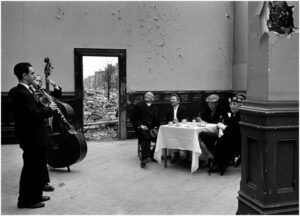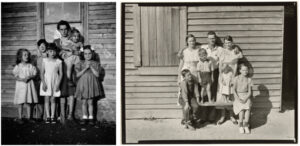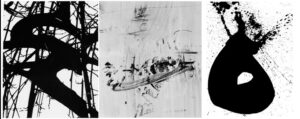
Verner Reed and Historic New England
In 2002, Verner and Deborah Reed gave Historic New England 26,000 negatives encompassing Reed’s work as a freelance photographer in the third quarter of the twentieth century. His photographs include “portraits, landscapes, and images capturing special moments and current events, document[ing] urban and rural life in New England from the 1950s to the ’80s.” This gift greatly expanded Historic New England’s mid-twentieth century’s photography collection.
In 2004, while Verner Reed was still alive, Historic New England mounted an exhibition, and published a catalog of the exhibition, entitled A Changing World: New England in the Photographs of Verner Reed 1950-1972.
By 2022, Historic New England was “Celebrating the twentieth anniversary of the Verner Reed Archives”.
Who was Verner Reed?
The following short biography comes from an article by Nancy Wolfe Stead, “The Life and Times of Verner Zevola Reed III” in the Stowe Guide and Magazine, Summer/Fall 2021, p.86-92. Nancy Stead knew Verner Reed personally during his years in Stowe, and recounts from memory numerous episodes of “mayhem, fun, and outlandish enterprise”.
Verner Reed, “furniture maker, sculptor, jeweler, and photographer, was born in 1923 in Denver. . . Verner’s early years were spent in New York, Boston, and Stowe, where his father had built Edson Hill Manor as a wedding present for his wife. Following World War II and a stint in the U.S. Army Air Corps in Burma, China, and India, he became a builder of fine, handcrafted furniture. Marketing his product introduced him to the camera, and photography quickly became his passion.
A chance meeting with a LIFE bureau chief at a 1953 rally in Boston before the impending execution of Julius and Ethel Rosenberg opened an immense new arena for Verner. He became a freelance photographer for LIFE and, as his skills and interests deepened, he added Fortune, Paris Match, Time, and regional publications such as Vermont Life and various newspapers to his roster. He always worked freelance, refusing to be tied down, and he chose his subjects, exploring and exalting in the streets, neighborhoods, celebrations, losses, and people of his world.”
For more biographical information, see vernerreed.com/biography.
The images
In Brunswick Hotel, the featured image at the top of the blog post, “Reed clearly relished the simple irony that emerges between the decorum maintained by the sitters and the decrepitude of their environs. Yet, his chosen moment reveals a final twist: these Bostonians recognize their situation; they celebrate long-standing traditions even as they acknowledge changing times.”*
Verner Reed’s work in photography is informed by his times and his surroundings, rooted in New England. It is also clear that he has taken to heart Henri Cartier-Bresson’s definition of photography written in the text accompanying the iconic work, Images à la sauvette / The Decisive Moment (1952). “Photography is the simultaneous recognition, in a fraction of a second, of the significance of an event as well as of a precise organization of forms which give that event its proper expression.” **
Reed cultivated a photographer’s eye. In The Photographer’s Eye, based on the Museum of Modern Art’s 1964 exhition showcasing the history of photography, John Szarkowki wrote, “Photography alludes to the past and the future only in so far as they exist in the presnt, the past through its surviving relics, the future through prophecy visible in the present.”*** Verner Reed was always conscious of this elusive aspect of time.

Walker Evans, Sharecropper’s Family, Hale County, Alabama, 1935.
In 1960, Verner Reed stopped to take a picture of a family in their yard in Northern Vermont. According to the description accompanying the photograph in Historic New England’s collection, “they asked for a minute to tidy up. The mother did not feel that she had enough presentable clothes for all of her children, and made some of them stay indoors–they can just be seen looking out the window.” Twenty five years earlier, Walker Evans had taken a series of pictures of George Burroughs and his family during the Depression in Hale County Alabama. The similarity of these two images is remarkable.

Norman Rockwell, Art Critic, 1955.
Ever the alert street photographer, Reed captured an image of a man enthralled by the sculpted head of a woman at the Boston Arts Festival in 1954. A year later, Norman Rockwell painted what looks like this man’s twin brother in a similar quizzical state for the cover of the April 16 Saturday Evening Post. The resemblance might be a coincidence, but it serves to highlight that both artists are reaching for that “decisive moment”, in this case in two very different mediums. Reed’s work is more contemplative, not aiming only for a quick laugh.

Verner Reed, Soaped Window, Boston, 1953.
Robert Motherwell, Untitled, 1967.
Tree Branches and Soaped Window, both dated in the early 1950s, provide evidence that Reed was cognizant of what was going on in the art world outside of New England. Painters who came to be called Abstract Expressionists were creating a body of work that was shifting the focus of the art world from Paris to New York. The abstract nature of the patterns created in Verner Reed’s photographs echo Robert Motherwell’s ink, watercolor and pencil drawings in The Mexican Sketchbook (1941) as well as Motherwell’s later starkly defined black and white paintings.
Historic New England and Digital Commonwealth
Historic New England’s mission is to “save and share New England’s past to engage and inform present and future generations.” Like any similar institution, Historic New England’s job encompasses preservation and access. Reed’s gift of his 26,000 negatives gave Historic New England the opportunity to preserve and catalog the images, to mount a number of exhibitions, and to publish an exhibition catalog. Anyone with a Massachusetts public library card has access to the print edition of A Changing World, and can see Verner Reed’s photographs in print.
By comparison, Digital Commonwealth’s mission is to enhance access to cultural heritage materials held by Massachusetts libraries, museums, historical societies, and archives, a bigger piece of the pie. “Access to knowledge and information is core to the purpose and structure of the Digital Commonwealth.” Along with 1850 collections from 235 institutions, Digital Commonwealth provides online access to 89 images in Historic New England’s Verner Reed Photographic Collection, 1950-1972.
Barbara Schneider, Member, Digital Commonwealth Outreach Committee
Retired Head Law Librarian, Massachusetts Trial Court Law Libraries
*John R. Stomberg, Essay in A Changing World: New England in the Photographs of Verner Reed 1950-1972, Historic New England, 2004. p. 8.
**Henri Cartier-Bresson, The mind’s eye: Writings on Photography and Photographers, Aperture, 1999. p. 42.
***John Szarkowski, The Photographer’s Eye, Museum of Modern Art, 1966. p. 10.
